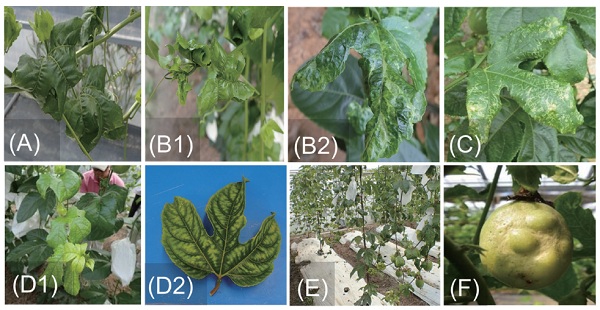Current issue

Author:Atsushi Ajitomi*, Akari Saito, Shinji Kawano, and Ken-taro Sekine
Abstract:
In Okinawa Prefecture, passionfruit cultivation during the winter and spring seasons has become problematic due to the emergence of symptoms, e.g., shriveled new leaves and reduced plant vigor. In 2017, a survey of 84 fields was conducted across the region. The symptoms of suspected virus diseases were confirmed, and the outbreaks of 6 specific viruses in Japan were further investigated via reverse transcription-polymerase chain reaction (RT-PCR). The results showed that the top three common symptoms were the curling of adult leaves, leaf surface cracking, and yellowing between leaf veins. Among the 6 viruses tested, East Asian Passiflora distortion virus (EAPDV), East Asian Passiflora virus-AO (EAPV-AO), and Passiflora latent virus (PLV) gave an incidence of 2.4%, 1.2%, and 85.7%, respectively, whereas Broad bean wilt virus-2 (BBWV-2), Cucumber mosaic virus (CMV), and EAPV-IB were not detected. Plants infected with EAPDV and EAPV-AO showed typical symptoms of leaf shriveling and fruit malformation, but those infected with PLV showed several other nonspecific symptoms. Based on the survey results, PLV was identified as the primary pathogen. The virus was isolated from infected passionfruit, causing symptoms in quinoa but not in passionfruit. PLV was also confirmed to be transmitted by insect vectors, e.g., cotton aphids, as well as by juice remaining on pruning shears. Furthermore, as PLV was detected in passionfruit seedlings obtained from a supplier, thus the supply of confirmed PLV-free seedlings was established as a countermeasure in Okinawa starting from 2019. Since then, the occurrence of PLV has dramatically decreased, as revealed in a second field survey conducted in 2022 showing a significantly lower number of PLV-infected fields. Abnormal symptoms of passionfruit and high incidence of PLV infection showed a strong positive correlation in Okinawa.
Key words:Aphid, Pruning shears, RT-PCR, DECS-C, Carlavirus
Download:![]() PDF Links
PDF Links
 Submit your manuscript
Submit your manuscript
 Guide for authors
Guide for authors